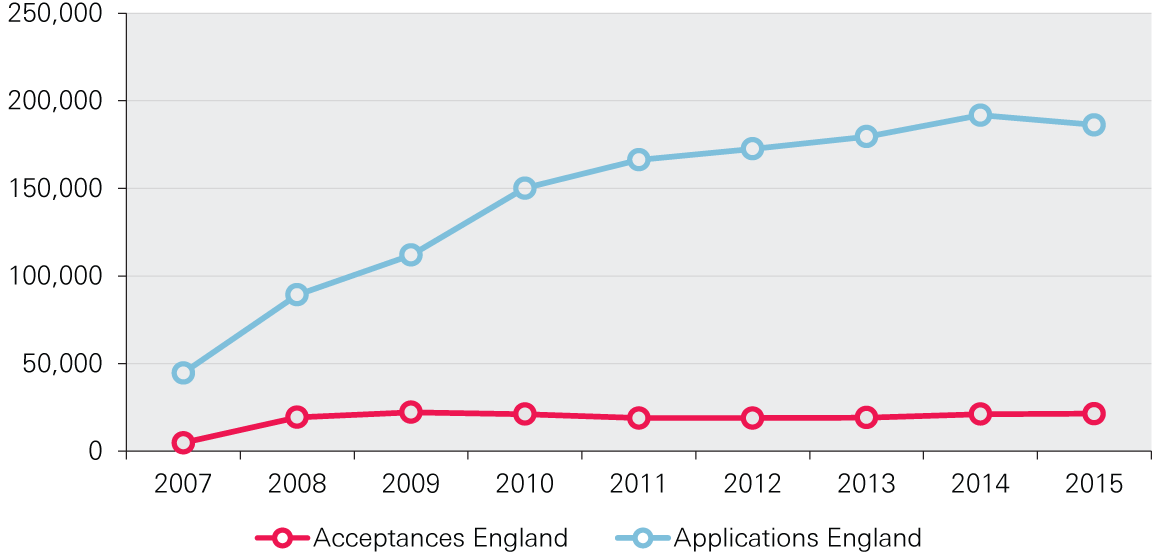Demand pressures on the NHS rise every year. To cope with these pressures and provide the same quality of service, we need to train more clinical professionals and nurses in Britain year after year. But we trained 19% fewer nurses in 2015 than a decade ago.
The problem of understaffing in the NHS has been well-documented. A National Audit Office report stated that there was a shortfall of 28,000 for nurses, midwives and health visiting staff. It’s a serious issue: an overworked team is more likely to make mistakes and neglect patients.
So what’s the answer?
The government has just confirmed it is going ahead with plans to remove the bursary that student nurses receive to fund their study and help with living costs. It says this will increase the number of people training to become a nurse, as well as the number of training places on offer.
But how can increasing the price of training really lead to more nurses? It’s oddly reassuring when a question of economics comes down to a case of supply and demand.
The NHS Bursary Scheme creates a fixed supply of nurses entering the system each year. We can only train the nurses that Health Education England (HEE) can afford to fund. The table below shows the extent of the restrictions using UCAS data for applications and places offered in England.
Around 20,000 nurse training places have been offered each year since 2010, but due to the attrition rates and the number of experienced staff leaving the service, the nurse population has grown by only 2,700 over this period according to Health and Social Care Information Centre (HSCIC) staff data. In fact, the number of practicing nurses per capita for the whole of the UK fell between 2010 and 2013, according to 2015 OECD health statistics.
The government’s aim to achieve a balanced national budget means that finding additional funding for new places would be difficult. Instead, it will remove NHS bursaries in favour of a traditional student loan scheme. The government has said this will lead to 10,000 additional places between 2017 and 2020 – equivalent to 3,300 per year.
But a more affordable training scheme for the government means a transfer of burden to students. London Economics estimates that this will increase the cost to students by 71% overall. Future cohorts of nurses will, unfortunately, feel the brunt of this new policy, entering a difficult profession in debt.
So, with student loans replacing grants and tuition fees costing £9,000 per year, the question is will there be enough people interested in a nursing career to fill the extra training places?
UCAS data indicates that there is an overwhelming demand for nurse training: it estimates that 57,000 potential students applied for 21,450 awarded places in 2015.
If bursary reform does lead to an additional 3,300 training places per year, then HSCIC figures suggest that 62% will go into nursing – equivalent to 2,046 extra places per year on average. Therefore a total of 23,496 places could be filled per year. If the same numbers of people apply as in 2015, there would still be 2.4 applicants for every nurse training place.
|
Number of nurse training places awarded in 2015 |
Estimated number of additional places following NHS bursary removal |
Estimated total number of places following NHS bursary removal |
Estimated number of applicants for nurse training places in 2015 |
Implied applicants per place |
|
21,450 |
2,145 |
23,496 |
57,000 |
2.4 |
London Economics has estimated that the cost of higher education to nurses will increase by 71% and, with it, an expected fall of 6.1% in training places. However, we argue that the response to a cost increase would be seen in the number of applications – not training places. With courses oversubscribed to the extent that they are, the question is whether the removal of the bursary is likely to discourage enough applicants that it affects filled training places.
In fact, 59% of applicants would need to pull out before the number of filled training places is affected. In other words, potential nursing students would have to be almost 10 times more responsive to an increase in costs than London Economics have stated.
Regardless of any fall in the number of applications, these changes may also affect the mix of trainees. Almost 40% of nurse trainees are over 25. This group, who are more likely to have families and prior qualifications, may be the hardest hit by this policy change. In an effort to address this, the government has set out a series of measures to try to ensure nursing training remains accessible to all.
Overall though, the evidence suggests that, due to the high number of applications, any surplus places offered are likely to be filled.
There are already examples of universities and hospitals setting up nursing courses, which students pay for via the standard student loan scheme. These schemes have proved popular. The course at the University of Bolton was significantly oversubscribed with over 650 applications for 25 places in September 2015. Other local NHS employers have since joined the initiative.
However, we can’t be certain what the future holds. The removal of the bursaries must therefore be accompanied with a plan for what happens if the number of applicants does fall by 60% or more. Training more nurses is essential, and this reform will help liberalise the labour market so it can react more efficiently and help meet the growing demand for clinical staff. However, the long-term success of these reforms will depend on nursing becoming an attractive career option.
Toby Watt (@tlswatt) is a Finance Analyst at the Health Foundation
Further reading
Work with us
We look for talented and passionate individuals as everyone at the Health Foundation has an important role to play.
View current vacanciesThe Q community
Q is an initiative connecting people with improvement expertise across the UK.
Find out more



